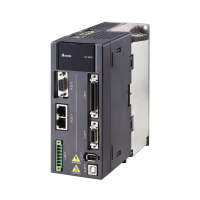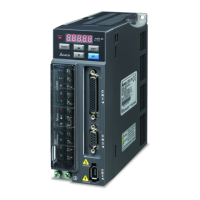AH500 Programming Manual
2-8
S
Exponent
Mantissa
8-bit 23-bit
b
31
b
0
Sign bit
0: Positive
1: Negative
Equation:
The single-precision floating-point numbers range from ±2
-126
to ±2
+128
, and correspond to the range
from ±1.1755×10
-38
to ±3.4028×10
+38
.
The AH500 series PLC uses two consecutive registers to form a 32-bit floating-point number. Take
(D1, D0) for example.
S E7 E6 E5 E1 E0 A22 A21 A20 A6 A5 A4 A3 A2 A1 A0
b0b1b2b3b4b5b6b20b21b22b23b24b28b29b30b31
2 2 2 2 2 2 2 2 2 2 2 2 22 2
D1(b15~b0) D0(b15~b0)
Exponent (8 bits)
Mantissa (23bits)
Mantissa sign bit (0: Positive; 1: Negative)
When b0~b31 are zeros, the content is zero.
The position where the decimal point is hidden
2.2.2.2 Double-precision Floating-point Numbers
The floating-point number is represented by the 64-bit register. The representation adopts the
IEEE754 standard, and the format is as follows.
S
Exponent
Mantissa
11-bit
52-bit
b
63
b
0
Sign bit
0: Positive
1: Negative
Equation:
The double-precision floating-point numbers range from ±2
-1022
to ±2
+1024
, and correspond to the
range from ±2.2250×10
-308
to ±1.7976×10
+308
.
The AH500 series PLC uses four consecutive registers to form a 64-bit floating-point number. Take
(D3, D2, D1, D0) for example.
S E10 E9 E8 E1 E0 A51 A50 A49 A6 A5 A4 A3 A2 A1 A0
b0b1b2b3b4b5b6b49b50b51b52b53b60b61b62b63
2 2 2 2 2 2 2 2 2 2 2 2 22 2
10 9 8 1 0 -1 -2 -3 -46 -47 -48 -49 -50 -51 -52
D3(b15~b0)
D2~D0
Exponent
(11 bits; signed value)
Mantissa (52 bits)
Mantissa sign bit (0: Positive; 1: Negative)
When b0~b63 are zeros, the content is zero.
The position where the decimal point is hidden
Example 1:
23 is represented by the single-precision floating-point number.
Step 1: Convert 23 into the binary number, i.e. 23.0=10111.
Step 2: Normalize the binary number, i.e. 10111=1.0111 ×2
4
(0111 is the mantissa, and 4 is the
exponent.).
Step 3: Get the value of the exponent.
∵E-B=4→E-127=4 ∴E=131=10000011
2

